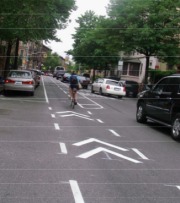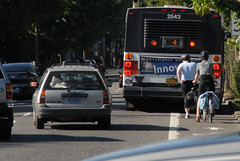
and a cramped bike lane on Williams
north of Morris.
(Photo © J. Maus)
While you may have already read our recap of the recent open house, there are a few more things about the N Williams Ave Traffic Safety Operations Project I want to share. In the paragraphs below you’ll find a response from City Traffic Engineer Rob Burchfield about two solutions that haven’t gotten much attention and you’ll hear from Bicycle Transportation Alliance Executive Director Rob Sadowsky what he thinks about the project.
One of the big issues on Williams is how to handle bus/bike conflicts. This is because the street is a frequent service bus route and the stops are on the same side of the street as the bike lane. As you saw at the open house, one of the leading ideas to remedy the “leapfrogging” that occurs now is to create a new bus loading platform in the parking lane and put a cycle track curbside.
Another solution many people have wondered about, but that seems to have been scuttled by the Stakeholder Advisory Committee, is to put the bike lane on the left side of the street (it’s a one-way) so as to avoid the conflicts altogether. Displays at the open house listed several disadvantages of the left-side bike lane including: motor vehicle operators who expect bike traffic on their right, conflicts with left-turning traffic, difficult right-turns for bike traffic, and safety concerns with bike traffic being next to the faster-moving travel lane.
But their are advantages too: no more right-hooks, no more bus/bike conflicts, fewer parked cars to open doors into bike riders, and so on.

(Photo: PBOT)
I asked PBOT City Traffic Engineer Rob Burchfield why the left-side bike lane option wasn’t being pursued further. Here’s what he said:
“The Stakeholder Advisory Committee discussed the option of a left side bike facility. They felt that a right side bike facility was a better option if there is a workable design solution that resolves the bus/bike conflict. One of the primary reasons for their preference is the belief that the majority of cyclists’ destinations are east of Williams. In addition, there is a design challenge with the ‘two-stage right turn’ from a left side cycle track. We sought additional input on the left/right question at the open house and we have not eliminated it from consideration.”
So, if you are a proponent of the left-side solution, get your comments into PBOT project manager Ellen Vanderslice (ellen.vanderslice@portlandoregon.gov).
The other issue I asked Burchfield about has to do with variable lane configurations in Segment 4 (between N Cook and Skidmore). This is the segment where PBOT is considering doing nothing to enhance the bikeway (other than some traffic signal which are unfunded) because of push-back from business owners and concerns about maintaining current motor vehicle trip volumes (I can’t believe I actually just wrote that, but it’s true).
I’ve heard from several people that, because the high traffic demand in this segment occurs only for two hours a day, perhaps PBOT could adjust lane usage for specific times of day. I asked Burchfield if that solution was feasible:
“The basic answer to your question is yes, but we haven’t developed nor vetted any concepts that include this idea. We will develop some concepts for this idea and and discuss them with the SAC. We do have a concern that the parking demand in segment 4 is high during the peak travel times, but we will research this further.”
And finally today, we hear from the BTA. The BTA has been quiet about this project thus far, so I called Executive Director Rob Sadowsky to hear what he thinks. Sadowsky said he has some concerns that certain options were discarded prematurely, “just because of fear or not understanding how it work.” He mentioned the left-side bike lane option and a shared bus/bike lane option as examples.
“We’re in a little bit of a wait and see mode to see how the final recommendations come out.”
— Rob Sadowsky, BTA
In terms of a public stance on the project, Sadowsky said, “We’re in a little bit of a wait and see mode to see how the final recommendations come out. We wanted to see how the open house went on Saturday to see what was trending.” (The BTA has a staff member of the Stakeholder Advisory Committee.)
When it comes to Segment 4, Sadowsky put his weight behind a one-lane option (reducing it from the current two motor vehicle lanes). “I think one lane would work, I generally think road diets work everywhere… I don’t think that two lanes is what’s neccessary to create a vibrant business district. In fact, I think it creates the opposite.”
PBOT’s Vanderslice says they’re still going through feedback from the open house last Saturday and they will present results at the May 3rd stakeholder committee meeting. The committee will guide the process in developing a recommended alternative and PBOT will share that alternative with the community at an open house in early June.
Stay tuned for more reporting on this project. Previous coverage here.


